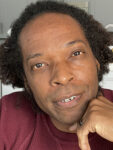By John E. Finley-Weaver

SAN DIEGO — The Zone of Interest begins in a darkness and silence that very, very thoroughly prepare the audience for the coming light and sound . . . a light and sound that only begin to appear after a seemingly eternal 90-odd seconds, perhaps even TWO minutes.
Soft, osteal light appears at the screen’s center and the calming sounds of an arboreal sanctuary rise in volume to reveal a relaxed and happy family, picnicking in bathing suits beside a sluggish, unhurried river.
They leave during the night in two automobiles for home.
Their home and garden, their domestic Lebensraum, or living space, is lit by the morning sun, and is adjacent to a high and sturdy wall crowned by barbed wire. Roofs and chimneys and smoke stare down at the ground.
Between the wall and the home, Schutzstaffel officers collectively wish Kommandant Rudolf Höss a happy birthday.
I then thought to myself, Okie-dokie, Zone of Interest, I’m fascinated and ready for this journey with you . . . .
Hey, Reader.
Yeah, you.
The greatest boon in engaging in genocide for Führer, Hausfrau, and commoner is getting other people’s stuff. Rudolf Höss accrues and exercises power, earns respect and fear, and steals like an upper-class thief. Meanwhile, Hedwig, his devoted wife and doting mother of five happy and healthy children, embodies the evil banality of SS housewifery. She and her coterie of officers’ wives are hind-walking hyenas in whitelace trim, causally humblebragging of their gifted victories on the domestic front: a high-end lipstick found in a mink coat pocket here, a serendipitously-discovered diamond smuggled in a tube of toothpaste there.
They are National Socialist Scavengers, ghouls feasting on Jewish carrion, minus a crumb or two tossed to the Polish “hired” help. Hedwig Höss is a Teutonic death doula, assisting her Rudolf in Auschwitzing misery, pain, and ash. She is the perfect yin complement to her husband’s yang, which he uses, off-screen to pleasure himself with one of his prisoners, and washes, on-screen before retiring for the night at his wife’s side.
Hedwig Höss’ character reminds me of two of her recent, cinematic kin. The first, in both historical and release-date order, is Laura Cayouette’s Lara Lee Candie-Fitzwilly, in Quentin Tarantino’s Django Unchained (2012), set in the fictional Candyland slave labor camp of ante-bellum Mississippi. Candi-Fitzwilly is the widowed Southern belle of every Gone with the Wind, Birth of a Nation knock-off. She is attractive, pampered, and politely oblivious to the multigenerational horrors and sexualized abuses that allow her to have soft hands, sun un-kissed skin, and the oh-so purtiest of tailored dresses. She is the social magnet and domestic goddess of her not-quite incestuous brother’s fleshy business dealings.
And then, there is Hedwig Höss’ second sister: Ashlie Atkinson’s Connie Kendrickson of Spike Lee’s BlacKkKlansman (2018), set in 1970’s Colorado Springs, Colorado. Kendrickson is the scruffy-around-the-edges, fiercely rabid, and madly devoted wife of working-class Klansman, Felix Kendrickson. A feminist role model of sorts, as befitting the era of the film’s timeline, she is a one-woman, bomb-toting auxiliary, and completely unaware of the Jewish, undercover cop in her home, sharing beers with her husband.
Hilarity ensues.
Aside from its photographic and acting achievements, The Zone of Interest is an audio designer’s playground. A quick internet scrolling of nominations and awards reflects the deliciously-insane and meticulous efforts put forth to make the specific and properly-distanced and almost not subtle anguish and violence that are just a tightly-wadded paper ball’s throw away.
Violence that is never shown. Only heard.
So, prick up your ears and let the light flow over you.
*
John E. Finley-Weaver is a student of the parallels and contrasts between the Jewish and African-American experiences.